Sculpture for National World War I Memorial receives national TV and print coverage
May 2022 was a great month for national awareness about the new National World War I Memorial in Washington, DC, as work on the sculpture received great television and print coverage. First was Smithsonian Magazine (circulation on the order of 2 million) with a massive 16-paqe in-depth article about sculptor Sabin Howard's studio in New Jersey. Then shortly before Memorial Day, the Fox 5 New York television station visited the studio in Englewood for a terrific broadcast piece interviewing Howard and some modern-day veterans there to look at the sculpture in progress. The piece was picked up by dozens of Fox stations across the country and rebroadcast to millions of potential viewers nationwide, including Alaska and Hawaii.
 Interview by Fox 5 televison station in New York was seen nationwide.
 The Doughboy Foundation partners with Verizon to bring WWI Memorial "Virtual Explorer" AR App to K-12 educators
Matthew Barker, Baltimore Symphony Orchestra Member: "Nothing is more humbling than playing Taps.”
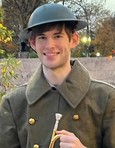
This month, Matthew Barker, who prefers to be called Matt, shares his unique story with us as one of the buglers who sounds Daily Taps at the National World War I Memorial, “Rain or Shine.”
Says Matt, “I grew up in Houston, Texas, and currently live in Columbia, MD. I'm a full-time member of the Baltimore Symphony Orchestra trumpet section; I won that position in 2016. A trumpeter friend of mine who is the main bugler at the WW1 memorial graciously asked me to play Taps on occasion, as my schedule allows." Click here to read more, and find out how sounding Taps has a deeply personal meaning for Matt.
|

Picking up where they left off in 2021, the U.S. Army Band "Pershing's Own" is back at the National World War I Memorial in Washington, DC this summer for a series of Thursday Evening Rush Hour Concerts from June through September, weather permitting. The concerts are part of the band's 100th anniversary year. Here are the planned dates and times for the 2022 series:
-
Thursday, June 30, 6:30 pm, Brass Quintet
-
Thursday, July 7, 6:30 pm, Jazz Combo
-
Thursday, August 11, 6:30 pm, Army Band ensemble
-
Thursday, August 18, 6:30 pm, Army Band ensemble
-
Thursday, August 25, 6:30 pm, Army Band ensemble
-
Thursday, September 1, 6:30 pm, Army Band ensemble
-
Thursday, September 8, 6:30 pm, Concert Band
-
Thursday, September 15, 6:30 pm, Concert Band
-
Thursday, September 22, 6:30 pm, Army Band ensemble
-
Thursday, September 29, 6:30 pm, Army Band ensemble
The Band starts to set up at the Memorial after the completion of Daily Taps at 5:00 pm, and the concerts start promptly at 6:30.pm. There is plenty of seating at the Memorial with good views of the band. In case of inclement weather on a concert day, check the Band's web site or social media to determine the status of the event.
National World War I Memorial has Doughboy in Uniform Playing 'Taps' Every Night
On Memorial Day, remember Meuse-Argonne
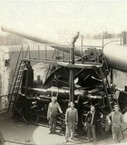
On Saturday morning, March 24, 1917, a telegram messenger shouted the awful news from the front gate, across the Poor family’s Illinois front yard and into their windows. Their son was dead. Pvt. John Poor was killed the previous day in a midnight shootout at Fort Williams, far away, on the coast of Maine. German spies were thought to be responsible. Click here to read more, and learn how, though the country didn’t officially enter WWI for another 10 days, Poor’s death while guarding the seaside battery in Cape Elizabeth, likely made him the first serviceman to die in the line of duty while serving in the United States’ armed forces during the “War to End All Wars.”
|

"Hopefully the word 'finally' has come to pass, and we won’t be doing this again anytime soon," said Jeremiah O’Connor, as a new monument to his uncle, a fallen World War I soldier, was unveiled Friday. It's the third time O'Connor's family has tried to honor Carlo Lafazia, who was killed on French soil, fighting back the Germans in a final Allied assault during the Meuse-Argonne Offensive. He died Oct. 11, 1918, one month before the war ended. Click here to read more, and learn how two previous memorials to Lafazia in Providence disappeared or were destroyed.
|

Louisiana’s Fort Polk could be renamed, along with eight other U.S. Army installations around the nation which were originally named for Confederate leaders. The announcement comes from the military’s Naming Commission, which has submitted its report to Congress. Under the recommendation, Fort Polk could be renamed to Fort Johnson, in honor of Sgt. William Henry Johnson, an African-American World War I Medal of Honor recipient from North Carolina who served in the 369th U.S. Infantry Regiment. Click here to read more about Johnson's heroic service in World War I, and the Naming Commission's report.
|
“We were young, they say. We have died. Remember us.”
This is how Eddie Rickenbacker earned
7 service crosses and the Medal of Honor
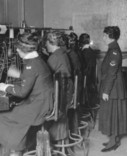
Writing for the Daily Kos web site, Lenny Flank takes a look at how "during the First World War, the US Army depended for most of its tactical communications upon a small group of female volunteers called 'the Hello Girls'." He notes how, for military communications, "the armies of the First World War turned to another new technology—the telephone...During the Great War, troops on all sides laid thousands of miles of telephone wires." Flank notes further that "When the United States entered the war in 1917, General John “Black Jack” Pershing needed to set up a similar communications network. But there was a problem: the US Signal Corps had fewer than 1600 men, and most of them were telegraph operators who had never been trained to run a telephone switchboard." Click here to read the entire article, and learn how Pershing asked the famous "Hello Girls" to solve his critical problem, and how they responded.
|
The Man Nobody Knew and Facial Wound Narratives after World War I
Two U.S. Army soldiers who served
in both the Civil War and World War I
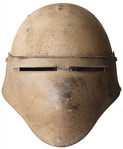
When America entered World War I in 1918, the United States military was equipped with the then-modern Model 1903 Springfield rifle, but it lagged behind in new technologies like machine guns, and modern metal helmets. Most U.S. soldiers were issued a helmet that wasn’t really all that different from the British MkI “Tin Hat,” which had been introduced in the early months of 1916. The United States would continue to wear the basic helmet — albeit with an updated liner — until 1940. Yet, largely forgotten is the fact that the United States had sought to develop its own helmet during the war. Click here to read more, and learn how several models were actually considered, how Dr. Bashford Dean became an important name in the discussion.
|

British historian Dr. Mark Felton takes a look on his YouTube channel at how, in New York in 1919, two strange pyramids were built as part of US victory celebrations. The pyramids were made from captured German Pickelhaube, the iconic spiked helmet. Click here to view the video, and read the accompanying article from the Rare Historical Photos web site, as Felton explores the long and colorful history of the iconic Pickelhaube, how they fell ingloriously out of use in the carnage of World War I, how the artifacts ended up in New York City after the war, and how there could be one still floating around out there that might be worth a whole lot of money.
|
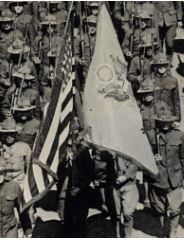 |
|
World War I was The War that Changed the World, and its impact on the United States continues to be felt a century later, as people across the nation learn more about and remember those who served in the Great War. Here's a collection of news items from the last month related to World War I and America. |
What Was a Doughboy?
Reviewing A Machine-Gunner In France
WWI Memorial one of 10 New Attractions to Visit in D.C.
Who Are They? Men in the 369th Infantry Iconic Photo
The Harlem Hellfighters of World War I
Michigan-Wisconsin division had major role in World War I
Landmarks Illinois publishes WWI Monuments of Illinois Database
Three East Greenwich WWI Veterans Who Didn’t Come Home
Ripon American Legion named for 1st casualties of WWI, WWII
Seven Indiana WWI heroes followed for PBS documentary
Memorial Day: The True Reason for the Season
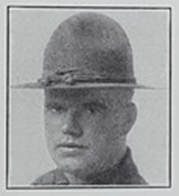
A man is only missing if he is forgotten.
Our Doughboy MIA this month is 1st LT Arnold Matthew McInery.
Born April 23rd, 1893, Lieutenant McInery was a student at Notre Dame University when war broke out. He enlisted in the first officer’s training program at Ft. Benjamin Harrison on May 15th, 1917. Upon completion of his training he was commissioned a 2nd Lieutenant and went overseas with the 9th Infantry Regiment, 2nd Division. While leading his company into an attack during the Battle of Soissons on July 18th, 1918, Lt. McInery was killed in action and interred in a makeshift battlefield grave, which was never located after. The company he led into battle that day was later decorated by the French for bravery in action during that attack.
Would you like to help us solve this case? Give 'Ten For Them' to Doughboy MIA and help us make a full accounting of the 4,423 American service personnel still listed as missing in action from WW1. Make your tax deductible donation now, with our thanks.
|
Merchandise from the Official
Doughboy Foundation WWI Store
|